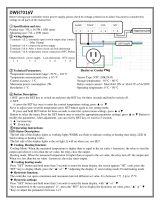13
3.3 Setting values
Changing a setting:
H1 (H2) Control circuit→ Setting values
The regulator has two types of setting values: those that are al-
ways visible and those than can only be changed using a service
code (see page 35).
Both circuits have the same circuit-specific setting values.
• Choose the desired setting by turning the control knob.
• Press OK to go to the view where editing is possible. Change the
setting.
• Press OK to accept the change.
• If you want to exit edit mode without making any changes, press
ESC.
H1 Control circuit
Info
Heating curve
Setting values
Control mode Automatic
>
>
>
>
Send a message: H1 Settings.
The controller sends settings to your mobile phone. Editing the setting values:
write the new setting in place of the old setting and send a message back to the
controller. The controller sends back the setting as a confirmation.
H1 Setting values
H2 Setting values
H1 Setting values:
Room temperature = 21.5°C/
Temperature drop = 3.0°C/
Key words:
Setting Factory
setting Range Explanation
Room temperature setting 21.5 5... 50 °C Basic room temperature setting for the controller set by the user. This
setting value is not visible unless room compensation is in use. The
room compensation can be taken in use from the “Room temperature
settings” menu.
Summer function outdoor t.
limit
19.0 10 ... 35 °C Summer function outdoor temperature limit. When the measured
or forecast outdoor temperature exceeds the outdoor tempera-
ture limit of the summer function, the valve will be closed and the
circulation water pump will stop as selected. The summer function
is switched o, when the temperature drops 0.5 °C under sum-
mer function outdoor temperature limit. In this case, the pump is
switched on and the valve returns back to control mode.
Pump summer stop In use In use/
Not in use
If the controller is connected to control the pump, the pump can
be stopped when the summer function is active.
Valve summer close In use In use/
Not in use
The setting value is used to select whether or not the valve is
closed when the summer function is in use.
Autumn dr y eect on supply water
Autumn dry eect on room temp.
4.0
1.0
0... 25 °C
0.0... 1.5 °C
The setting value defines how much the autumn dry function in-
creases supply water temperature. If room temperature regula-
tion is in use, the user sets how much the room temperature is
increased.
Room compensation settings
Room compensation In use In use/
Not in use
With room compensation it’s defined whether room temperature aects
regulation of supply water. If the measured room temperature diers
from its setting value, room compensation corrects the temperature of
the supply water.
Room compensation ratio 4.0 0...7 Coecient which is used in applying the dierence between room
measurement and the room setting value to the supply water set-
ting value. For example, if room temperature in radiator heating
is one degree below the setting value, supply water is raised by four
degrees.
Temperature drops
Temperature drop 3.0 0... 40 °C Temperature drop of supply water, which can start due to time pro-
grams or a Home/Away text message command or when selecting
continuous temperature drop as the circuit’s control mode. If room
temperature measurement has been taken into use, the temperature
drop is given directly as a room temperature drop.
Home/Away control Not in use In use/
Not in use
The Home/Away control changes the temperature levels. If transmit-
ter for general compensation is connected to controller, it’s not possibe
to connect Home/Away switch. In this case Home/Away mode can be
switched with SMS or from ”Inputs and Outputs” menu.























